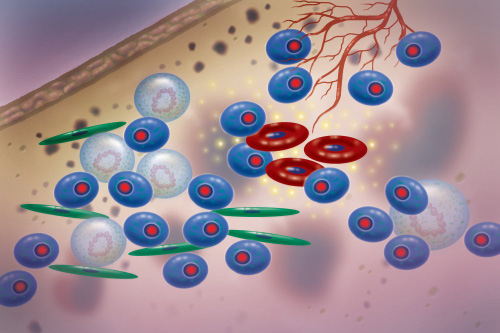[tribulant_slideshow gallery_id=”294″]
The month of March is dedicated to drawing even more attention than regular to multiple myeloma, a rare cancer that is affecting more and more human beings every year.
The Multiple Myeloma Research Foundation defines multiple myeloma as a form of blood cancer that develops in the bone marrow. In multiple myeloma, normal plasma cells transform into malignant plasma cells, which denotes that the cells become highly virulent and invasive, or in simpler terms, cancerous. This dangerous, new breed of cells then produces large quantities of an abnormal protein that interferes with regular blood cell production. These cells travel through the blood, forming multiple tumors in bone marrow throughout the body.
Plasma cells are a type of white blood cell that helps the body to rid itself of infections by creating antibodies that recognize, attack and kill germs; these cells are also referred to as immunoglobulins. Bone marrow is a soft, fatty substance located in the cavities of bones where blood cells, such as plasma cells, are produced.
Matured myeloma cells disrupt the process of plasma cells. In fact, these fully developed, cancerous cells do the opposite of the normal functioning, healthy, plasma ones. Matured myeloma cells fail to activate the immune system, which means that the immune system will no longer assist with identifying and attacking foreign substances that enter the body, leaving the body prone to a variety of physical functional disorders.
The American Cancer Society states that the lifetime risk of getting this rare cancer is one in every 143 people or 0.70 percent. This cancer organization has also estimated that for this year, the United States will diagnose approximately 30,770 new cases of multiple myeloma, and around 12,770 deaths are expected to result from the disease.
According to Mayo Clinic, most people are diagnosed with multiple myeloma in their mid-60s; therefore, there is a correlation between increasing age and the disease. Additionally, the male sex is more prone to the disorder than females, and those that belong to the black race are twice as susceptible as those from any other race.
The Multiple Myeloma Research Foundation has listed the most common multiple myeloma symptoms; which include fatigue, increased vulnerability to infections, increased or decreased urination, confusion, increased thirst, nausea, vomiting, loss of appetite and weight loss.
Persons suffering from this illness also experience bone lesions and low blood count. Bone lesions or bone pain and fractures are formed due to a high presence of plasma cells which weakens bone structure. Low blood count, on the other hand, is caused by a limited number of red blood cells and normal white blood cells resulting in anemia related problems and susceptibility to infections.
Hypercalcemia, a phrase for high levels of calcium, is also seen in multiple myeloma patients. Additionally, hypercalcemia, along with excess amounts of protein in the blood, are responsible for impaired kidney function, which is scientific jargon for overworked kidneys.
Moreover, the American Cancer Society details how persons who have developed one tumor in the bone are examined closely for multiple myeloma because this solitary abundance of plasma cells, termed solitary plasmacytoma, is highly likely to develop into cancer.
As of now, multiple myeloma is not categorized as a hereditary disease. It is suggested that exposure to certain chemicals or radiation can onset the development of the illness, but there is no strong evidence against this chemical/radiation exposure argument, and most cases are seen in individuals with no familiar risk factors. This signifies that the disease is unpreventable seeing that its risk factors are unknown; however, it is treatable.
The Multiple Myeloma Research Foundation states how early detection of multiple myeloma is not a simple task because there are barely any symptoms unique to the illness. Unfortunately, because of this reason, this particular cancer is often not detected until it progresses into its advanced stage with symptoms such as bone pain, fatigue, anemia and weight loss.
Persons who visit medical professionals for routine blood tests have a higher possibility of early detection and diagnosis; an unusually high level of protein present in the blood is an indicator of multiple myeloma.
Despite its rarity, treatment options are continuously improving for this cancer. Treatment plans can be especially composed based on an individual’s needs. These treatments include drug therapy to control and kill the myeloma cells, stem cell transplant, surgery, radiation therapy and alternative treatments, such as acupuncture and aromatherapy.
New research is currently being conducted to slow down the cancer and reduce bone destruction, according to the American Cancer Society. Additionally, according to the Multiple Myeloma Research Foundation, clinical trials are being held to generate new and better treatments, as well as aid in a greater comprehension of the nature of this illness.





